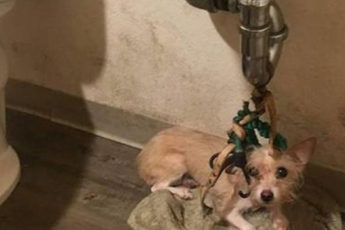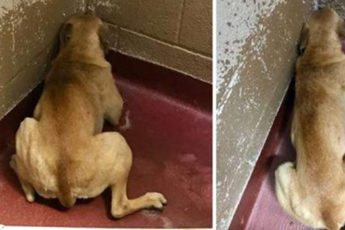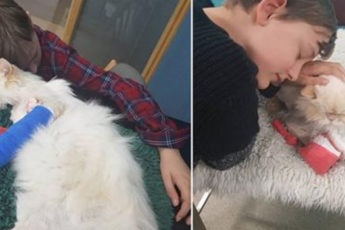We present to you, readers of humble feline notes, here is such a compilation of curious facts and just interesting data about four-legged furballs, that is, domestic cats. Some you may know, and some will be new.
50 facts about our favorite cats

– A cat’s heart beats up to 140 beats per minute, which is almost twice that of a human.
– It takes as much water to lick a cat’s fur as it does to urinate.
– A cat’s normal body temperature is about 38 degrees. It is slightly higher than a human’s.
– A cat’s skeleton has 250 bones. (Some sources call it 245 and say the bones can fuse together as they get older.) A human has 206.
– About 10% of all bones are in the tail. All for better balance when running and jumping.
– There are 517 muscles in a cat’s body. A human has 650 of them.
– To control the ear, cats have 32 muscles at their disposal. A cat’s ear rotates 180 degrees and does so ten times faster than a dog’s.
– A cat’s eye is larger relative to its body size than that of most mammals.
– Cats can distinguish some colors. Experiments have shown that cats can distinguish between red, green and blue. With other colors, however, the case is somewhat worse, that is, in shades of gray.
– Cats can see up to 60 meters. The field of clear vision is 135, and peripheral lateral vision is about 285 degrees.
– Cats are not very good at distinguishing small details.
– Cats need 6 times less light than humans to see at night. Their night vision is amazing! In the dark, a cat’s eye even uses light reflected from the retina.
– Kittens’ eye color can change as they get older.
– At birth, kittens are deaf and blind. They open their eyes at 7-10 days, and vision and hearing develop at two weeks.
– The pattern of lines on the surface of a cat’s nose is unique, just like a human’s fingerprint. No two cat noses are alike!
– Cats can smell up to 14 times stronger than humans. They have 80 million olfactory receptors in their noses.
– In addition to the nose, cats can pick up smells with the help of the so-called Jacobson organ, located on the upper palate behind the front incisors. A cat uses it when it concentrates completely on some particularly interesting smell, drawing in air by slightly lifting its upper lip and nose.
– With its vibrations, the cat perceives the smallest vibrations of air and its direction. A kind of natural direction finder! In total, the cat has 24 main vibrissae located in four rows on each side of the head. And the two upper rows of whiskers can be controlled by the cat independently of the lower.
– One of the largest breeds of cats is the Maine Coon. Cats weigh from 6 to 10 pounds, and cats – from 5 to 8 pounds. The smallest cat breed is the Singapore Cat. Cats weigh about 3 kilograms and cats barely gain 2 kilograms.
– The giraffe, camel, horse, and cat are the only non-walking animals that have their left legs go first and then their right legs when walking. This walking ensures speed, maneuverability, and quietness.
– Domestic cats are the only feline species capable of keeping their tails upright when walking. All wild cats hold their tails horizontally when walking.
– A cat only has sweaty paw pads.
– Cats usually have 1-6 kittens in a litter. On average, a cat can have 2-3 litters per year and can produce more than 100 kittens in its lifetime. One pair of cats and their offspring can produce 420,000 kittens in 7 years.
– One litter can have kittens from different fathers.
– When drinking, a cat grasps liquid with the lower side of its tongue more than with the upper.
– Cats purr at a frequency of 26 vibrations per second, and do so both on inhalation and exhalation.
– When hunting prey, domestic cats can make jerks at speeds of up to 40 kilometers per hour.
– In England, cats are used for their intended purpose of guarding granaries and other food stores, and are quite officially put on the payroll. Cats also protect books and other relics of the British Museum from mice. And in Austria, a cat who has served on the guard of the warehouses for several years is entitled to a pension for life, given out in food: milk, meat or broth.
– If a cat is near you and its tail is trembling, this is the highest feeling of love it can express. When the tail starts dropping, it means the mood has changed – you can step back, she won’t be offended.
– Cats wave their tails when they are faced with a choice, with one desire going against the other. For example, if the cat is standing in the doorway and wants to go out and it’s raining outside, the tail will swing because of an internal conflict. The cat wants to go out, but she doesn’t want to get wet. As soon as she makes a decision (to stay inside – or go out in the rain), the tail will immediately calm down.
– With pleasure, cats let out and retract their claws, spreading their fingers.
– Don’t pick up a kitten or even more so an adult cat by the scruff of the neck. You can never do it like a mother cat who carries her kittens this way. They go into a state of torpor. With this burden in its teeth, the cat is able to overcome a variety of obstacles and make jumps up and down.
– The average life span of a domestic cat is 15 years, while that of a wild cat is 3 to 5 years.
– People who have pet cats live longer and are much less likely to suffer from stress and heart attacks.
– A cat kills moving prey, but not necessarily for food. Understanding that hunting is for food is an acquired skill.
– A cat falling from a height always acts the same way. First the head aligns, then the back, then the legs, and finally the back arches out to soften the landing.
– “Sociable” cats follow you from room to room to control your actions.
– If the cat is yanking furniture, try giving the place a lemon or orange scent. Cats can’t stand the smell of citrus.
– Cats can discern intonation. When talking to them, be aware of the tone of voice. Cats know when you’re mad at them (though they may not show it).
– Cats can make about 100 different sounds. By comparison, dogs only make about 10.
– Cats purr not only for pleasure, but also to express pain or fear. Cats often purr when giving birth or when petting kittens.
– Cats rub against humans to “override” other people’s smells and appropriate their own. The smell comes from glands that are between the eye and ear and at the base of the tail. Cats lie down on their owners’ clothes for the same reason.
– Don’t put your cat on a vegetarian diet. They need animal protein. After all, they are carnivorous animals!
– Cats are some of the laziest mammals. They are capable of sleeping 18 hours a day. A cat falls asleep faster than almost any other animal.
– Cats, when not sleeping, spend a third of all their time grooming.
– A cat easily jumps to a height five times its height.
– Cats like heights – they can see the nearest space better from there. And enemies will not so quickly overcome the height to which the cat climbed. So do leopards and jaguars, which sleep in the trees.
– If a cat bites when its belly is stroked it does not mean that it is evil, it just does not like it.
– If a cat sleeps with all its paws under itself or curled up and its tail covering its nose, it’s a sign of cold weather.
– Modern cats are descended from myacids, small animals that lived in the trees. They existed more than 40 million years ago. The first members of the modern felines evolved about 12 million years ago.






















